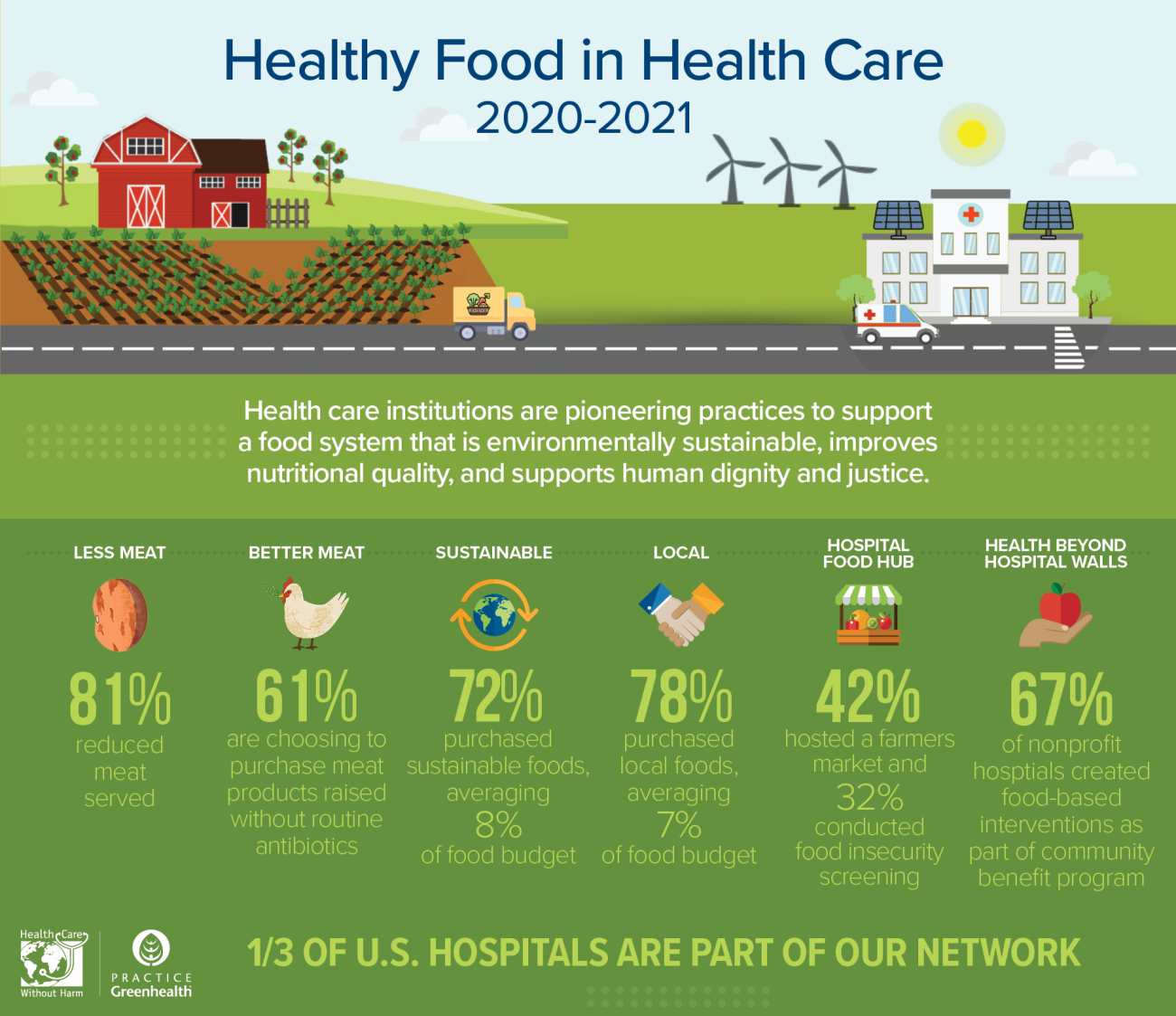Our initiatives
We work with hospitals and communities to implement successful strategies for food system improvement through our 3 initiatves:

Act now
Many leading health systems are partners of Practice Greenhealth, our membership organization. Practice Greenhealth provides tools, resources – such as Plant-Forward Future, our menuing, marketing, and culinary guidance – and a community of practice to implement sustainable strategies in health care. Practice Greenhealth helps partner hospitals facilitate the purchasing of food products that meet the criteria of our healthier food purchasing guidance and standards and achieve purchasing, climate mitigation, and equity benchmarks.
Through regional innovation projects, we work with hospitals and communities to co-create and implement successful strategies for food system improvement.
Trends show U.S. hospitals are changing the food system. Check out 2022 health care food trends.
Why healthy food in health care?
A new definition for “healthy” food
In the United States, the four leading causes of death – and largest sources of health care expenditure – are directly linked to food: stroke, diabetes, cancer, and cardiovascular disease. Our industrial food system poses environmental and human health risks through reliance on synthetic pesticides, fossil-fuel-based fertilizers, antibiotics, and hormones, as well as low-wage laborers who face unsafe working conditions. We know that with dietary changes and reduced food waste we can feed a growing global population in a sustainable way that supports human and environmental health.
Learn more:
Healthy food needs a healthy planet
Industrial agriculture is one of the biggest contributors of carbon emissions. The Intergovernmental Panel on Climate Change estimates that agriculture and associated land-use changes are responsible for 24% of global greenhouse gas (GHG) emissions – greater than emissions from industry and greater than the combined emissions of transportation and buildings. Animal agriculture alone accounts for 14.5% of GHGs globally. With climate change recognized as the biggest public health threat of the 21st century, hospitals can lead food system transformation and create healthier communities through supporting local, sustainable, and regenerative producers and serving foods with lower impacts on climate and the environment.
Learn more:

Our stories: Winning recipe comforts refugees and redefines hospital food
Shekeba Samadzada and Dan Hess on giving Afghan refugees a taste of home, serving plant-forward in the Midwest, and winning the 2021 Health Care Culinary Contest
Solving for waste, climate, and hunger
Hospitals generate over 30 pounds of waste per bed per day. It is estimated that 10-15% of the waste an average hospital creates is food waste – that’s about 288,401 tons of food waste generated per year from hospitals. The health care sector is responsible for nearly 10% of the country’s GHG emissions, and hospitals generate one-third of those emissions. At the same time, in 2020, 1 in 6 people in the United States experienced food insecurity. Experts have also projected that reducing food losses by just 15% would provide enough food for more than 25 million people living in the United States every year. Hospitals can recover edible food and donate it to community nonprofits along with other strategies to reduce their food waste, lower costs associated with waste management, and their facility’s climate impact.
Learn more:

Our stories: Food waste recovery partnership
An innovative hospital-nonprofit partnership program is recovering thousands of pounds of food and getting it to the people who need it – while cutting costs and greenhouse gases. The story of Davis Community Meals and Housing and Sutter Health in Davis, California shows what is possible when communities come together to find health-promoting solutions.
A new vision for food supply chains
Health care can play a critical role in protecting workers, community health, and the planet through local and ethical food purchasing practices. Learn how hospitals are investing in production and processing infrastructure to make purchasing local foods year-round easier, how institutions are combining their purchasing power to create sales pathways for businesses owned by people of color and women and develop ethical and sustainably produced products, and how hospitals have the opportunity to impact the communities involved in their supply chains through their purchasing choices.
Learn more:
Co-create community resilience
Health Care Without Harm leads the health care sector in moving beyond doing “less harm” (reducing negative impacts from health care operations) to a future where the sector “heals” or restores ecological, economic, and social capital within communities. Hospitals hold significant real estate investments, are often among the largest employers in their communities, and employ individuals who are well-connected in the community. As anchor institutions, hospitals are committing to leveraging their social and economic influence for better public and environmental health through sourcing local food and investing in more sustainable and equitable food system initiatives. Community benefit investments are one pathway for nonprofit hospitals to address healthy food access and strengthen the food system. Learn how hospitals can battle hunger and disease with plants and accelerate best practices to promote healthy food access and healthier food systems.
